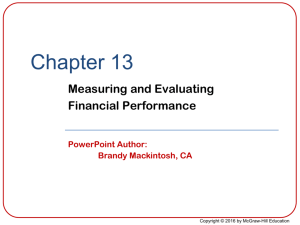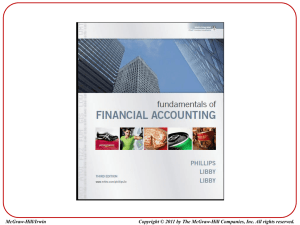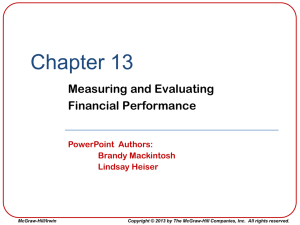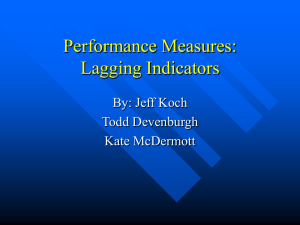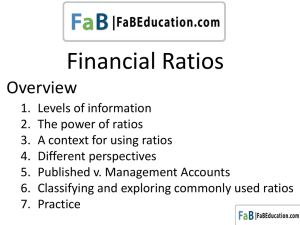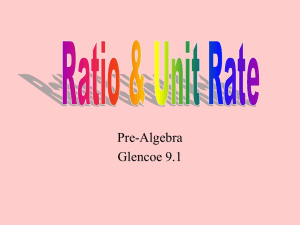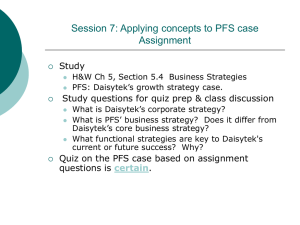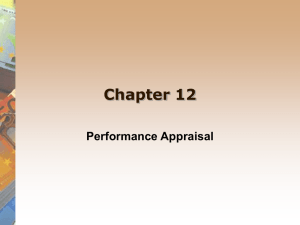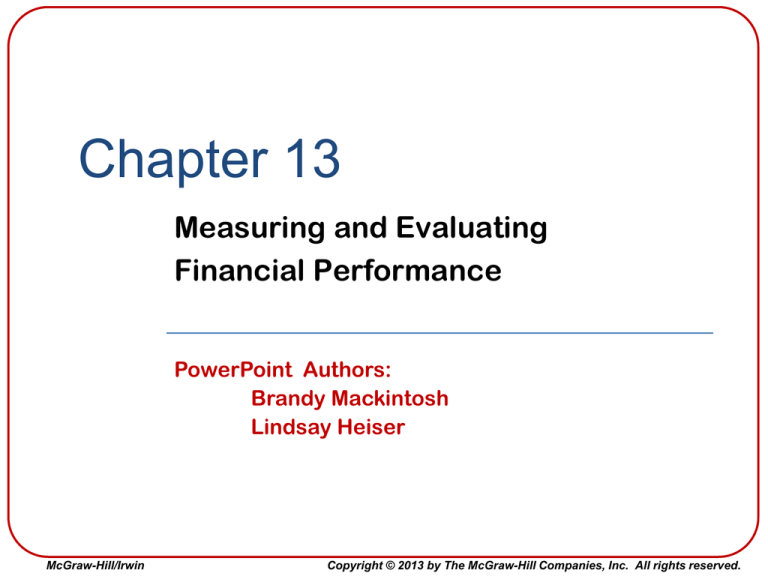
Chapter 13
Measuring and Evaluating
Financial Performance
PowerPoint Authors:
Brandy Mackintosh
Lindsay Heiser
McGraw-Hill/Irwin
Copyright © 2013 by The McGraw-Hill Companies, Inc. All rights reserved.
Learning Objective 13-1
Describe the purpose and
uses of horizontal, vertical,
and ratio analyses.
13-2
Horizontal, Vertical, and Ratio
Analyses
Horizontal (trend) analyses are conducted to help financial statement
users recognize important financial changes that unfold over time.
12/31/12
Gross Profit in 2012
Trend Analysis
12/31/13
Gross Profit in 2013
Δ in Gross Profit $
and/or % from 2012
Vertical analyses focus on important relationships between items on the
same financial statement.
2013
Amount
Sales
Cost of Goods Sold
Gross Profit
13-3
$200,000
150,000
$ 50,000
Percent
100%
75%
25%
Horizontal, Vertical, and Ratio
Analyses
Ratio analyses are conducted to understand relationships among various
items reported in one or more of the financial statements.
Receivable
Turnover
Ratio
=
Net Sales Revenue
Average Net Receivables
It is essential to understand that no analysis is complete unless it leads
to an interpretation that helps financial statement users understand and
evaluate a company’s financial results
13-4
Learning Objective 13-2
Use horizontal (trend) analysis
to recognize financial changes
that unfold over time.
13-5
Horizontal (Trend) Computations
Trend analyses are usually calculated in terms of
year-to-year dollar and percentage changes.
Let’s look at an example
13-6
Horizontal (Trend) Computations
$48,815 – $47,220
× 100
$47,220
Now let’s calculate the percentage
Calculate
Now
Can
let’s
youlook
the
calculate
change
at the remainder
the
in dollars
dollar and
for
of the
Net
change in Net Sales Revenue between
Sales
trend
percentage
analysis
Revenue
change
ofbetween
the Income
for Cost
2010Statement.
ofand
Sales?
2009.
2009 and 2008.
13-7
Learning Objective 13-3
Use vertical (common size)
analysis to understand
important relationships within
financial statements.
13-8
Vertical (Common Size) Computations
Vertical, or common size, analysis focuses on
important relationships within financial statements.
Income Statement
Sales = 100%
Balance Sheet
Total Assets = 100%
Cost of Sales
× 100
Net Sales Revenue
13-9
Learning Objective 13-4
Calculate financial ratios to
assess profitability, liquidity,
and solvency.
13-10
Ratio Computations
Ratio analysis compares the amounts for one or more line
items to the amounts for other line items in the same year.
Ratios are classified into three categories . . .
Solvency ratios
examine a company’s
ability to pay
interest and repay
debt when due.
Profitability ratios
examine a company’s
ability to generate
income.
Liquidity ratios
help us determine if a
company has sufficient
current assets to repay
liabilities when due.
13-11
Common Profitability Ratios
13-12
Common Liquidity Ratios
13-13
Common Solvency Ratios
13-14
Learning Objective 13-5
Interpret the results of
financial analyses.
13-15
Interpreting Horizontal and Vertical
Analyses
Lowe’s began relying more on debt and
less equity financing. Long-term
liabilities increased 28.7 percent and
stockholders’ equity decreased by 5%.
13-16
Lowe’s assets
grew only by
2.1% in fiscal
2010.
Interpreting Horizontal and Vertical
Cost of sales and operating expenses
Analyses are the most important determinants of
the company’s profitability.
The increase in Net
Income in fiscal 2010
is explained by the
increase in Net Sales
Revenue and the
decreases in Cost of
Sales and Operating
Expenses as a
percentage of sales.
13-17
Interpreting Horizontal and Vertical
Analyses
Lowe’s has experienced a small
Lowe’s did a better job of
controlling its Operating
Expenses between 2009
and 2010.
13-18
decrease in its percentage of Cost of
Sales in relation to Sales Revenue from
fiscal 2009 to 2010. Decreasing cost of
sales means higher Gross Profit.
Ratio
Calculations
13-19
Ratio Calculations
13-20
Profitability Ratios
Net Profit Margin – The slowly improving economy helped boost
Lowe’s profits in 2010 as shown by the increase in Net Profit
Margin.
Gross Profit Percentage – Lowe’s gross profit percentage indicates
how much profit was made on each dollar of sales after deducting
the Cost of Goods Sold.
13-21
Profitability Ratios
Asset Turnover Ratio – indicates the amount of sales revenue
generated for each dollar invested in assets during the period.
Fixed Asset Turnover – indicates how much revenue the company
generates in sales for each dollar invested in fixed assets,
Home Depot 2010 fixed asset turnover ratio was 2.69
13-22
Profitability Ratios
Return on Equity (ROE) – Compares the amount of net income to
average stockholders’ equity. ROE reports the net amount earned
during the period as a percentage of each dollar contributed by
stockholders and retained in the business.
Earnings Per Share (EPS) – Shows the amount of earnings
generated for each share of outstanding common stock.
13-23
Profitability Ratios
Price /Earnings (P/E) Ratio – Shows the relationship between EPS
and the market price of one share of the company’s stock.
13-24
Liquidity Ratios
Let’s change our attention to an examination of liquidity
ratios. The analyses in this section focus on the
company’s ability to survive in the short term, by
converting assets to cash that can be used to pay current
liabilities as they come due.
Receivable Turnover Ratio – Most retail home improvement
companies have low levels of accounts receivable relative to sales
revenue because they collect the majority of their sales
immediately in cash.
Receivable
Turnover
Ratio
13-25
=
Net Sales Revenue
Average Net Receivables
Liquidity Ratios
Inventory Turnover Ratio – The inventory turnover ratio indicates how
frequently inventory is bought and sold. The “days to sell” indicates the
average number of days needed to sell each purchase of inventory.
Home Depot sells its inventory in an average of 85 days in 2010.
Current Ratio – The current ratio measures the company’s ability to
pay its current liabilities
13-26
Liquidity Ratios
Quick Ratio – The quick ratio is a much more stringent test of
short-term liquidity than is the current ratio. Lowe’s quick ratio
increased slightly in 2010, just as its current ratio did.
Referred to as “quick assets.”
Let’s examine some Solvency Ratios
Solvency ratios focus on a company’s ability to survive over the long
term, that is, its ability to repay debt at maturity and pay interest prior to
that time.
13-27
Solvency Ratios
Debt to Assets Ratio – indicates the proportion of total assets that
creditors finance.
In 2010, The Home Depot had a debt-to-assets ratio of 53 percent.
Times Interest Earned – indicates how many times the company’s
interest expense was covered by its operating results.
13-28
Learning Objective 13-6
Describe how analyses
depend on key accounting
decisions and concepts.
13-29
Underlying Accounting Decisions
and Concepts
Accounting Decisions
Difference in Strategies,
e.g. type of financing.
Difference in Operations,
e.g. quality of items sold.
Difference in Accounting
Methods, e.g. FIFO vs. LIFO.
13-30
Accounting Concepts
Companies may elect to use any acceptable generally
accepted accounting principle (GAAP) as long as they
apply the principle consistently.
13-31
Conceptual Framework for Financial
Accounting and Reporting
13-32
Factors Contributing to Going-Concern
Problems
Factors that commonly contribute to
going-concern problems are listed below.
13-33
Chapter 13
Supplement 13A
Nonrecurring and Other Special
Items
McGraw-Hill/Irwin
Copyright © 2013 by The McGraw-Hill Companies, Inc. All rights reserved.
Nonrecurring Items
13-35
Extraordinary Items
Very few events qualify as
extraordinary items.
Cumulative Effect of Changes in
Accounting Methods
Direct adjustment to Retained Earnings rather
than income reporting.
Discontinued Operations
For discontinued component two items are reported:
1. Operating income prior to the date of disposal.
2. Gain or loss on sale or disposal of net assets.
Nonrecurring Items
NONRECURING ITEM
Discontinued Operations.
13-36
Other Special Items
Comprehensive Income includes:
1. Gains or losses from certain foreign currency
exchange rate changes.
2. Gains or losses resulting from the change in value
of certain types of investments.
Excluded from net income
because they are likely to
disappear before they are
ever realized.
13-37
Chapter 13
Supplement 13B
Reviewing and
Contrasting IFRS and
GAAP
McGraw-Hill/Irwin
Copyright © 2013 by The McGraw-Hill Companies, Inc. All rights reserved.
Overview
At a basic level both IFRS and GAAP are concerned with
accounting rules that describe
1) when an item should be recognized in the accounting
system,
2) how that item should be classified (asset , liability, equity,
expense, or revenue), and
3) the amount at which each item should be measured.
IFRS
13-39
Yes
Report fixed assets at
fair value.
No
GAAP
Chapter 13
Solved Exercises
M13-1, M13-2, M13-6, E13-1, E13-3,
E13-4, E13-10, E13-13
McGraw-Hill/Irwin
Copyright © 2013 by The McGraw-Hill Companies, Inc. All rights reserved.
M13-1 Calculations for Horizontal Analyses
Using the following income statements, perform the calculations
needed for horizontal analyses. Round percentages to one decimal
place.
13-41
M13-1 Calculations for Horizontal Analyses
($100,000 – $75,000)
× 100 = 33.3%
$75,000
13-42
M13-2 Calculations for Vertical Analyses
Refer to M13-1 . Perform the calculations needed for vertical analyses.
Round percentages to one decimal place.
$21,000
$100,000
13-43
× 100 = 21.0%
M13-6 Inferring Financial Information Using Gross Profit
Percentage and Year-over-Year Comparisons
A consumer products company reported a 25 percent increase in sales
from 2012 to 2013. Sales in 2012 were $200,000. In 2013, the company
reported Cost of Goods Sold in the amount of $150,000. What was the
gross profit percentage in 2013? Round to one decimal place.
Sales ($200,000 x 1.25)
Cost of Goods Sold (given)
Gross Profit
$250,000
(150,000)
$100,000
100.0%
-60.0%
40.0%
$100,000
× 100 = 40.0%
$250,000
13-44
E13-1 Preparing and Interpreting a Schedule for Horizontal
and Vertical Analyses
The average price of a gallon of gas in 2010 jumped $0.43 (18 percent) from $2.36 in
2009 (to $2.79 in 2010). Let’s see whether these changes are reflected in the income
statement of Chevron Corporation for the year ended December 31, 2010 (amounts in
billions).
Required:
1. Conduct a horizontal analysis by calculating the year-over-year changes in each
line item, expressed in dollars and in percentages (rounded to one decimal place).
How did the change in gas prices compare to the changes in Chevron Corp.’s total
revenues and costs of crude oil and products?
2. Conduct a vertical analysis by expressing each line as a percentage of total
revenues (round to one decimal place). Excluding income tax and other operating
costs, did Chevron earn more profit per dollar of revenue in 2010 compared to 2009?
13-45
E13-1 Preparing and Interpreting a Schedule for Horizontal
and Vertical Analyses
Req. 1
The 18% increase in the average gas price was less than the 19.2%
increase in total revenues and more than the 16.0% increase in cost of
crude oil and products. It appears from this analysis that the increase in
gas prices explains only part of Chevron’s increase in total revenues. Note
that the percentage increase in total revenues was similar to the
percentage increase in the cost of crude oil and products, suggesting the
costs of crude oil really did increase a lot in 2010, necessitating the
increase in gas prices.
13-46
E13-1 Preparing and Interpreting a Schedule for Horizontal
and Vertical Analyses
Req. 2
As a percent of total revenues, Chevron’s cost of crude oil
and products was higher in 2009 (58.1%) than in 2010
(56.6%). This implies that Chevron earned more profit
(excluding income tax and other operating costs) per dollar
of revenues in 2010 than in 2009.
13-47
E13-3 Preparing and Interpreting a Schedule for Horizontal and
Vertical Analyses
According to the producer price index database maintained by the Bureau of Labor
Statistics, the average cost of computer equipment fell 4.8 percent between 2009 and
2010. Let’s see whether these changes are reflected in the income statement of
Computer Tycoon Inc. for the year ended December 31, 2010.
Required:
1. Conduct a horizontal analysis by calculating the year-over-year changes in each
line item, expressed in dollars and in percentages (rounded to one decimal place).
How did the change in computer prices compare to the changes in Computer
Tycoon’s sales revenues?
2. Conduct a vertical analysis by expressing each line as a percentage of total
revenues (round to one decimal place). Excluding income tax, interest, and operating
expenses, did Computer Tycoon earn more profit per dollar of sales in 2010
compared to 2009?
13-48
E13-3 Preparing and Interpreting a Schedule for Horizontal and
Vertical Analyses
Req. 1
The 4.8% decrease in the average price of computer equipment was less
than the 16.7% decrease in total revenues. It appears from this analysis
that the 4.8% decrease in computer prices was not offset by an increase in
Computer Tycoon’s sales volume. In fact, the sales volume also decreased,
leaving an overall decrease in sales revenues of 16.7%.
13-49
E13-3 Preparing and Interpreting a Schedule for Horizontal and
Vertical Analyses
Req. 2
Excluding income tax, interest, and operating expenses
(i.e., looking at gross profit), we see that Computer Tycoon
earned 40.0% gross profit in 2010, which is down from
40.4% in 2009. In other words, Computer Tycoon earned
0.4 cents less (40.0 – 40.4) per dollar of revenues in 2010
than in 2009.
13-50
E13-4 Computing Profitability Ratios
Use the information in E13-3 to complete the following requirements.
Required:
1. Compute the gross profit percentage for each year (one decimal place).
Assuming that the change for 2009 to 2010 is the beginning of a
sustained trend, is Computer Tycoon likely to earn more or less gross
profit from each dollar of sales in 2011?
2. Compute the net profit margin for each year (expressed as a
percentage with one decimal place). Given your calculations here and
in requirement 1, explain whether Computer Tycoon did a better or
worse job of controlling operating expenses in 2010 relative to 2009.
3. Computer Tycoon reported average net fixed assets of $54,200 in 2010
and $45,100 in 2009. Compute the fixed asset turnover ratios for both
years (round to two decimal places). Did the company better utilize its
investment in fixed assets to generate revenues in 2010 or 2009?
4. Computer Tycoon reported average stockholders’ equity of $54,000 in
2010 and $40,800 in 2009. Compute the return on equity ratios for both
years (expressed as a percentage with one decimal place). Did the
company generate greater returns for stockholders in 2010 or 2009?
13-51
E13-4 Computing Profitability Ratios
Req. 1 Gross Profit Percentage = Net Sales Revenue - Cost of Goods Sold
Net Sales Revenue
2009 =
$120,000 - $71,500
$120,000
=
0.404 or
40.4%
2010 =
$100,000 - $60,000
$100,000
=
0.40 or
40.0%
If these results are the beginning of a sustained trend,
then it is likely that Computer Tycoon will have lower total
revenues in 2011, and a decline in gross profit
percentage. The gross profit percentage of 40.0% means
that the company generated 40.0 cents of gross profit on
each dollar of sales in 2010, which was down almost half
of one cent from 2009. If this continues, the company
could be expected to generate even less gross profit from
each dollar of sales in 2011.
13-52
E13-4 Computing Profitability Ratios
Req. 2
Net Profit Margin =
Net Income
Total Revenue
2009 =
$6,025
$120,000
=
0.050
or 5.0%
2010 =
$2,500
$100,000
=
0.025
or 2.5%
Computer Tycoon did a worse job of controlling expenses (other than
the cost of goods sold) in 2010 relative to 2009 because the net profit
margin decreased 2.5% (5.0 – 2.5) at the same time that the gross
profit percentage decreased only 0.4% (from 40.4% to 40.0%).
13-53
E13-4 Computing Profitability Ratios
Req. 3
Fixed Asset Turnover =
Total Revenue
Average Net Fixed Assets
2009 =
$120,000
$45,100
=
2.66
2010 =
$100,000
$54,200
=
1.85
The company better utilized its investment in fixed assets in
2009. Its fixed asset turnover ratio fell from 2.66 in 2009 to
1.85 in 2010. The 2010 ratio means that the company
generated $1.85 of sales revenue for every dollar invested in
fixed assets.
13-54
E13-4 Computing Profitability Ratios
Req. 4
Return on Equity (ROE) =
Net Income
Average Stockholders' Equity
2009 =
$6,025
$40,800
=
0.148 or
14.8%
2010 =
$2,500
$54,000
=
0.046 or
4.6%
The company generated better returns for
stockholders in 2009 (14.8%) than in 2010 (4.6%).
13-55
E13-10 Inferring Financial Information from Profitability and
Liquidity Ratios
Dollar General Corporation operates approximately 9,400 general
merchandise stores that feature quality merchandise at low prices to meet
the needs of middle-, low-, and fixed-income families in
southern, eastern, and mid-western states. For the year ended January 28,
2011, the company reported average inventories of $1,643 (in millions) and
an inventory turnover of 5.39. Average total fixed assets were $1,427
(million), and the fixed asset turnover ratio was 9.13.
Required:
1. Calculate Dollar General’s gross profit percentage (expressed as a
percentage with one decimal place). What does this imply about the
amount of gross profit made from each dollar of sales? TIP: Work
backward from the fixed asset turnover and inventory turnover ratios to
compute the amounts needed for the gross profit percentage.
2. Is this an improvement from the gross profit percentage of 31.3 percent
earned during the previous year?
13-56
E13-10 Inferring Financial Information from Profitability and
Liquidity Ratios
Req. 1
We can get the net sales number from the fixed assets turnover ratio and the
cost of goods sold number from the inventory turnover ratio, as shown below.
Fixed asset turnover =
Net sales ÷ Average fixed assets
9.13
=
Net sales ÷ $1,427,000,000
9.13 x $1,427,000,000 = Net sales
$13,028,510,000 =
Net sales
Inventory turnover
= Cost of goods sold ÷ Average inventory
5.39
= Cost of goods sold ÷ $1,643,000,000
5.39 x $1,643,000,000 = Cost of goods sold
$8,855,770,000 =
Cost of goods sold
So, Gross profit percentage = (Net sales – Cost of goods sold) ÷ Net sales
= ($13,028,510,000 – $8,855,770,000) ÷ $13,028,510,000
= 0.320 or 32.0%
13-57
E13-13 Analyzing the Impact of Selected Transactions on the
Current Ratio
The Sports Authority, Inc., is a private full-line sporting goods retailer.
Assume one of the Sports Authority stores reported current assets of
$88,000 and its current ratio was 1.75, and then completed the
following transactions:
1) paid $6,000 on accounts payable,
2) purchased a delivery truck for $10,000 cash,
3) wrote off a bad account receivable for $2,000, and
4) paid previously declared dividends in the amount of $25,000.
Required:
Compute the updated current ratio rounded to two decimal places,
after each transaction.
13-58
E13-13 Analyzing the Impact of Selected Transactions on the
Current Ratio
Start
Transaction (1)
Subtotal
Cash
Transaction (2)
Subtotal
Transaction (3)
Cash
Subtotal
Transaction (4)
Subtotal
13-59
Current
Current Assets
Current Liabilities
Ratio
(CA)
(CL)
(CA ÷ CL)
$88,000 ($88,000 ÷ 1.75)
$50,286
1.75
–6,000 Accts. pay.
82,000
–10,000
72,000
–6,000
44,286
1.85
44,286
1.63
44,286
–25,000
$19,286
1.63
No
impact*
Cash
72,000
–25,000 Dividends pay.
$ 47,000
2.44
End of Chapter 13
13-60

